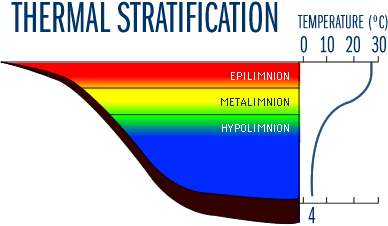






|
Temperature
-
The temperature of the lake changes with the depth of the water.
-
The temperature controls how quickly biological processes happen in the lake.
-
Most organisms that live in the lake don’t have the ability to control their own body temperature
-
Scientists measure the water temperature with specialized thermometers.
Temperature is one of the most important factors in determining which organisms live in a lake. The water can’t be too hot or too cold because the fish and other organisms don’t have a way to warm themselves up, they can’t put on another sweater and socks like we can. This is because fish are exothermic, meaning that they don’t have a way to control their own body heat. As the weather becomes cooler, the underwater life begins to slow down; plants don’t produce as much energy, the fish don’t move as quickly and the chemistry of the water changes too. The water temperature directly impacts how quickly the chemical reactions happen in the water. For example, how quickly bacteria break down the organic matter that sinks to the bottom of the lake. Also, how easily oxygen moves from the air into the water for fish to breathe. The warmer the water is, the less oxygen it can contain and the faster the bacteria work.
In this data set, scientists recorded the water temperature every meter for fifteen meters using specialized thermometers. Why would they want to take fifteen temperature readings in one place? The answer is because lakes form specialized layers during certain times of the year, this is called stratification. The coldest, densest layer is called the hypolimnion. This water in this layer is usually 4 degrees Centigrade because that is the temperature at which water weighs the most. The top layer, which is usually the warmest and has the most activity, is the epilimnion. The layer between the two is called the metalimnion. All of these layers are essential to the health of the lake. The hypolimnion houses the bacteria, which recycle the nutrients in the lake and make them available for the plants and animals that also live in the lake. The epilimnion receives the most sunlight so that’s where the plants areable to photosynthesize, exchanging carbon dioxide for oxygen. The fish and other living organisms depend on the oxygen that the plants release back into the water. Scientists can determine the exact location and depth of these layers by using this temperature data. They can also use the temperature data to approximate the level of activity in the lake, how quickly the lake is warming up and cooling down.

Quick Definitions
Temperature: A measurement of the degree or amount of heat present in a substance
Organism: An individual plant, animal or single-celled life form
Lake stratification: Formation of separate layers of the lake due to changes in temperature |
|



